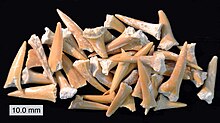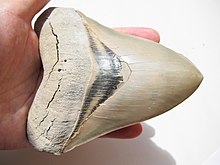Shark tooth


Sharks are a great model organism to study because they continually produce highly mineralized tissues.[2] Sharks continually shed their teeth and replace them through a tooth replacement system.[3] Through this system, sharks replace their teeth relatively quickly with replacement teeth that are ready to rotate because their teeth often get damaged while catching prey.[3] They will replace teeth that are broken and young sharks can even replace their teeth weekly.[3] Although sharks constantly shed their teeth, factors such as water temperature affect the turnover rate. While warmer water temperatures produced faster rates, cold water temperatures slowed tooth replacement rates in nurse sharks.[4] They are only shed once new teeth are formed underneath and push them out of the connective tissue that was holding them in place.[5] The sex of the shark also plays a role in the development of teeth and the differences in teeth in species due to gender is called sexual heterodonty.[6] Usually, females have larger teeth because on average they are usually larger than males.[6] Also, age can change the shape of teeth in which "juvenile teeth start out more narrow and robust, while adult teeth are broader and thinner".[6]
In some formations, shark's teeth are a common
The most ancient types of shark-like fish date back to 450 million years ago, during the
era (the last 66 million years).Types and functions
Though sharks often are highly specialized, as a category they have ranged widely in their adaptations. Their teeth reflect this, ranging widely in form and function.
There are a number of common types of shark teeth, that vary according to the diet of the shark. Examples include dense flattened teeth for crushing; long needle-like teeth for gripping; pointed lower teeth for gripping combined with serrated, triangular upper teeth for cutting, and teeth that are tiny, greatly reduced, and non-functional.[8]

Dense flattened teeth
Dense flattened teeth are used to crush prey like bivalves and crustaceans.[9] These sharks include nurse sharks and angel sharks. They are typically found at the bottom of the ocean floor.
Needle-like teeth
This was the first common style of shark tooth, present in the
Pointed lower teeth and triangular upper teeth
This combination of pointed lower teeth, with triangular upper teeth are especially useful for cutting prey that consist of large mammals and fish. The combination of teeth entails serrated edges to cut the larger prey into smaller portions in order to easily swallow the pieces.
Non-functional teeth
The teeth of plankton-feeders, such as the
Transitional teeth
As one species evolves into another, its teeth may become difficult to classify, exhibiting characteristics of both species. (Example: teeth from Otodus auriculatus as it evolved into O. angustidens) are difficult to definitively identify as coming from either species.

A commonly referred to transition is the evolution of Isurus hastalis, the extinct giant mako, into the great white shark, Carcharodon carcharias. There exist teeth that are believed to represent the transition between the two species. These teeth, from Carcharodon sp. are characterised by the wider, flatter crowns of the extinct giant mako. However, they also exhibit partial, fading serrations, which are more pronounced near the root, and disappear towards the tip of the tooth - serrations being found in great whites but not extinct giant makos.
Special mention: Megalodon teeth

Otodus megalodon teeth are the largest of any shark, extinct or living, and are among the most sought after types of shark teeth in the world. This shark lived during the late Oligocene epoch and Neogene period, about 28 to 1.5 million years ago, and ranged to a maximum length of 60 ft.[13] The smallest teeth are only 1.2 cm (0.5 in) in height, while the largest teeth are in excess of 17.7 cm (7.0 in). The smaller teeth ranging from 3+1⁄2" and 4+1⁄2" are more common finds, while teeth over 5", 6", and 7" are more rare.[13] These teeth are in extremely high demand by collectors and private investors, and they can fetch steep prices according to their size and deterioration.[13] The larger teeth can cost as much as 3,000 dollars.[14]
Deposits
Shark teeth cannot be collected from just any type of rock. Any fossils, including fossil shark teeth, are preserved in
Fossilized shark teeth can often be found in or near river bed banks, sand pits, and beaches. These teeth are typically worn, because they were frequently moved and redeposited in different areas repeatedly before settling down. Other locations, however, yield perfect teeth that were hardly moved during the ages. These teeth are typically fragile, and great care should be taken while excavating them.
Counting

In taxonomy, shark teeth are counted as follows: rows of teeth are counted along the line of the jaw, while series of teeth are counted from the front of the jaw inward.[19] A single tooth row includes one or more functional teeth at the front of the jaw, and multiple replacement teeth behind this.[20] For example, the jaws of a bull shark can have 50 rows of teeth in 7 series, with the outermost series functional, but most sharks have five series with the average shark having about 15 rows of teeth in each jaw.[17] The small teeth at the symphysis, where the two halves of the jaw meet, are usually counted separately from the main teeth on either side. Sharks are also known to lose at least one tooth per week. Due to their specific arrangement of rows and series however, lost teeth can be replaced within a day.[17]
Research and identification
Identification of most sharks are found through a combination of tooth counts and tooth shapes. Teeth can even lead to the identification of shark species like the
History of discovery


The oldest known records of fossilized shark teeth are by Pliny the Elder, who believed that these triangular objects fell from the sky during lunar eclipses.[26]
According to Renaissance accounts, large, triangular fossil
This interpretation was corrected in 1611 by the Italian naturalist Fabio Colonna, who recognized them as ancient shark teeth, and, in 1667, by the Danish naturalist Nicolaus Steno, who discussed their composition and famously produced a depiction of a shark's head bearing such teeth.[28] He mentioned his findings in a book, The Head of a Shark Dissected, which also contained an illustration of a C. megalodon tooth, previously considered to be a tongue stone.[29]
Tool use by humans

In
See also
- Elasmobranch
- Fish jaw
- List of sharks
References
- ^ "Shark teeth".
- PMID 22503701– via Elsevier Science Direct.
- ^ a b c Kardong, Kenneth (2019). Vertebrates: Comparative Anatomy, Function, Evolution. McGraw-Hill. p. 96.
- JSTOR 1445834.
- ^ a b "Ancient Sharks". Micronesian Conservation Coalition. 2015.
- ^ a b c Purdy, Robert W.; Lonardelli, Diane (1995). "Fossil Shark Teeth" (PDF). The Paleontological Society. pp. 1–2.
- ^ "Fossil folklore".
- ^ "Shark Savers :: Shark Teeth".
- S2CID 4024283– via Wiley Online Library.
- PMID 26020788.
- ^ a b c "What Do Sharks Eat – The Shark Diet". Types of Sharks.
- ^ a b c d Kardong, Kenneth (2019). Vertebrates: Comparative Anatomy, Function, Evolution. McGraw-Hill. pp. 507–508.
- ^ a b c d e The Zen Cart® Team; et al. "About Fossil Shark Teeth".
- ^ "6 plus inch Megalodon Sharks Teeth". 23 February 2020.
- ^ a b "FLMNH Ichthyology Department: Fossil Sharks". 5 May 2017.
- ^ OCLC 223251653.
- ^ a b c d "Sink your teeth into this: 20 facts about shark teeth". Beach Chair Scientist.
- ^ "Georgia State Fossil - Shark Tooth". 24 May 2014.
- ^ Case, Gerard (1967). "Fossil Shark and Fish Remains of North American". p. 2.
- ISBN 1-920033-01-7.
- ProQuest 51542224.
- .
- .
- .
- ProQuest 304460308.
- ^ "Sharks' teeth are falling! - Dharma Beach Bum". Dharma Beach Bum. Archived from the original on 2014-11-13.
- JSTOR 4065077– via JSTOR.
- ISBN 1-59158-265-2.
- ^ Bruner, John (1997). "The Megatooth shark". FLMNH. Archived from the original on 2007-12-28. Retrieved 2008-01-16.
- ^ "Treasures of Hawai'i : Shark Tooth Weapon". Bishopmuseum.org. Archived from the original on 2008-12-04. Retrieved 2008-11-27.
- ISBN 978-0-8248-1562-2.
- ^ Anthony Meyer (1995) Oceanic Art, v. 2, p. 579.
- ^ Métraux, Alfred (1946) Handbook of South American Indians, v. 1, p. 522, "The Guaitaca"
- ^ Greg Perino, c. 1950, Cahokia Brought to Life, pp. 66-67
- ^ Métraux, Alfred (1940), "Ethnology of Easter Island". Bernice P. Bishop Museum Bulletin (Honolulu: Bernice P. Bishop Museum Press) 160:404
Further reading
- Campbell, Sid (2006). "Shark-Tooth Weapons". Warrior Arts and Weapons of Ancient Hawaii. Berkeley, Calif: Blue Snake Books. OCLC 65400291.
- Castro, Jose (1983). The Sharks of North American Waters. College Station: Texas A&M University Press. ISBN 0-89096-143-3.
- Stevens, John D. (1987). Sharks. New York: NY Facts on File Publications. ISBN 0-8160-1800-6.
